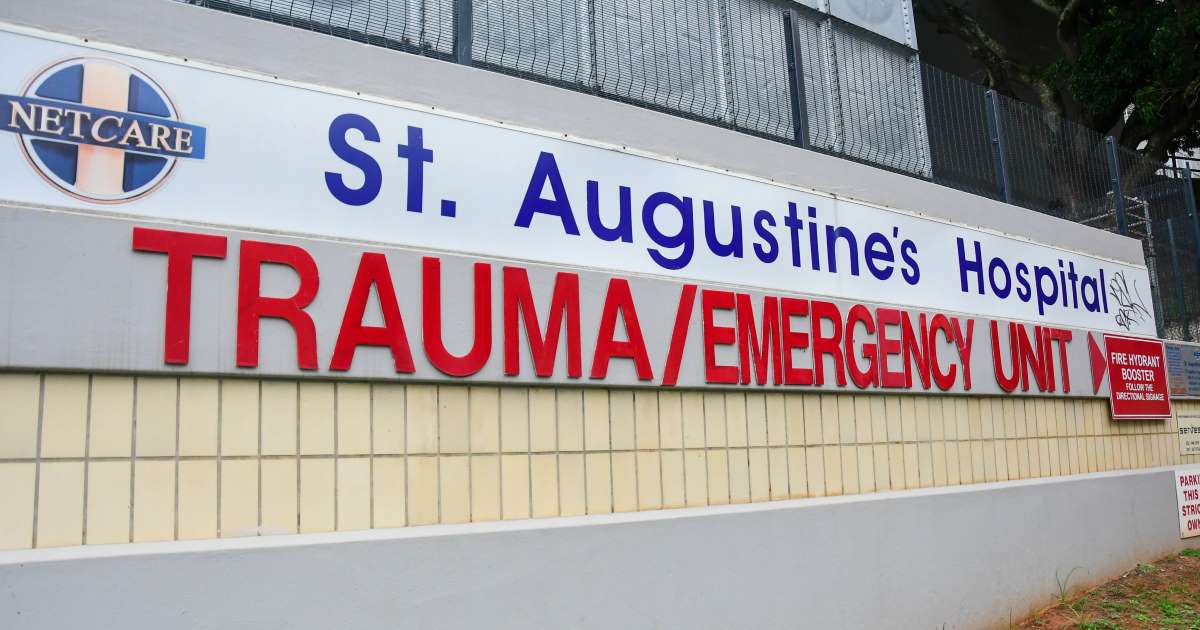
Durban – The outbreak of coronavirus disease at the Netcare St. Augustine’s Hospital in Durban, that led to the infection of at least 135 patients and staff in the hospital complex and people in a nursing home, was caused by a single patient admitted to the facility’s emergency department early in March, a new report has found.
The virus spread so fast in the hospital that infections caused by the outbreak in the hospital constituted almost 14% of Covid-19 cases in KwaZulu-Natal by the end of April.
The study, seen by Bhekisisa, was conducted by researchers at the University of KwaZulu-Natal’s (UKZN) Nelson R. Mandela School of Medicine and the KwaZulu-Natal Research Innovation & Sequencing Platform (Krisp).
The investigative report into the rapid spread of infections through the 469-bed facility holds crucial lessons for hospitals about the importance of proper infection control and the deadly consequences of identifying Covid-19 patients too late.
The SARS-CoV-2 virus, which causes Covid-19, had infected more than 17 200 people in South Africa by the end of Tuesday and caused 312 deaths, health department figures show.
Mathematical modelling estimates the country will reach the 30 000-mark in diagnosed Covid-19 cases by the end of the month and could see as many as 40 000 deaths by November, Health Minister Zweli Mkhize announced yesterday.
Spread quickly
From the emergency room at St. Augustine’s Hospital, SARS-CoV-2 spread quickly through the facility, infecting 80 staff and 39 patients in at least five different wards between 9 March and 30 April. The hospital outbreak led to an additional 21 cases, including four residents at a Durban nursing home and 17 patients and staff at St. Augustine’s outpatient dialysis unit.
That’s a total of 140 infections. But researchers found five cases they can’t be 100% sure came from inside the hospital, so they’re sticking to 135.
“Overall, we estimate that the hospital outbreak and its spread to these other institutions accounted for about 14% of Covid-19 cases in KwaZulu-Natal reported up to 30 April,” says Krisp director Tulio De Oliveria in a university statement.How did the virus spread so fast?By frequently moving patients around inside wards and from one ward to another, the researchers argue.
Patients were moved often between wards as the hospital began repurposing wards to prepare for an influx of Covid-19 cases. This way, health workers unknowingly exposed patients and colleagues to coronavirus patients who were still undetected.
The investigators found no evidence that the virus spread through the air.
The virus spreads from person to person through droplets that contain the virus, according to the World Health Organisation. The main way the virus spread through St. Augustine’s hospital, however, was through droplets left on surfaces and transferred by health workers.
The findings suggest that facilities be cleaned often, since the report shows the environment around a Covid-19 patient could be contaminated for hours or even days depending on the surfaces.
Hygiene
“Hand hygiene remains the most important intervention to prevent transmission of SARS-CoV-2 inside and outside hospitals,” the researches note.
The slow detection of cases also contributed to the rapid spread of the virus in the facility, the report shows. By the time the first case of the coronavirus disease was confirmed at the hospital, the report shows 16 other patients were already exposed to the virus.
Although the early cases at the hospital did not fit the typical profile – someone with fever, difficulty breathing, a cough or unexplained flu symptoms – for the disease being used in the country at the time, researchers found the facility did miss opportunities to curb infections.
For example, health workers failed to begin identifying people who may have been exposed to the new coronavirus to isolate them. Instead, they waited until the patient’s positive test results came back.
In those three days, staff did not investigate potential sources of infection. This patient would become the first case Covid-19 contracted inside the hospital.“The primary lesson learnt is that SARS-COV-2 can spread very rapidly in the hospital environment,” the researchers found.
Infection prevention
Going forward, hospitals will need strong infection prevention and systems in place to prevent such outbreaks, says the head of infectious diseases at UKZN’s medical school Yunus Moosa in a statement.
“We call on management to promote a culture in which infection prevention and control is everyone’s responsibility and that everyone has a role to play.” The researchers recommend all staff members at the facility are retrained in Covid-19 prevention, with a special focus on the importance of infection control and hand hygiene, which must be monitored by facilities.
Physical distance inside and outside the hospital is crucial, the experts warn, as well as possible weekly testing for all frontline staff. Plus, a three-tier system must be put in place for both entry and admission to the facility, the report found. It includes a “red zone” for confirmed Covid-19 patients, an “orange zone” for suspected cases, and a “green zone” for people who are unlikely to be infected.
The three zones must be clearly marked with signs on doors and floors, so that people know when they are moving from one to the other, and if it’s possible, facilities should devise plans to set up separate routes through the hospital to avoid overlap with green zones.
Vigilant
Hospital staff must remain vigilant for signs of respiratory illness throughout the facility but especially in green zones, the researchers say.
Early recognition and isolation of patients with suspected Covid-19 will be key to preventing repeat outbreaks at hospitals as the pandemic continues, the report shows.
When it comes to patients who are not yet showing symptoms of the infection – fever, cough or difficulty breathing – the experts suggest health workers adopt a healthy suspicion. The report concludes: “The safest approach is for healthcare workers to assume that all patients are potentially infectious with Covid-19 and to take precautions on that basis.”





